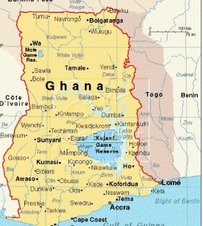A note from Tohajie: Here is another post from one of our family. Joan is a teacher from New Haven, Connecticut with four years of experience, but a lifetime of reflection. Enjoy...
My post will reflect an experience our group had on Tuesday, July 31st in the Kente-making center of Bonwire. Less than an hour from our hotel, it was a universe beyond my experiences.
First, to not mention Edna St. Vincent Millay's poem The Ballad of the Harp Weaver...what kind of a poetry enthusiast would I be? Those of you who have not read it, please do (read it out loud, slowly, and have a handkerchief nearby). As for Kumasi and the weavers of Kente cloth: nothing I've ever seen prepared me for the experience. It was "almost" many things I know, but not quite. The weavers were working inside a barn-like structure. The solid wood walls only rose for three feet or so, to reach the top of the cathedral-height ceiling was taut wire that formed an open grid. Draped and hanging from the wire walls was a herd of riotous colors; rather than animals or fowl, colors had been corralled.
When a piece of cloth is removed, the bright afternoon sun blazes in, dotting the dusty floor and dark faces in sporadic, geometric shapes. The patches of light, when they fell on a piece of folded fabric across the room, startled the eye to see color to a depth one normally doesn't grasp. Blues bounced, red reared up, yellows leapt, greens galloped--all the colors clashed, collided, banged, and bounced. It was like being caught in a downpour while--somehow--remaining dry. When the light fell on a face bundled in shadow, the body seated in a wooden web of woven cloth, it startled more than the eye: it startled the heart. The room seemed to have luminous coins flung about. I found it hard to concentrate on any one piece because, as fabrics were removed and rehung, beams of light as powerful and as focused as a police officer's flashlight moved about, pulling my eyes along with them.
Outside the locked door, the usual geography of hard-packed red earth, smooth stones, trees patiently crouching on knees and knuckles of roots, stretched in all directions; but inside, we were penned up in a throbbing, pulsing hive of hope and desperate salesmanship. To the men (recently, women have taken on the craft of weaving Kente cloth, but none were working at this location) these strips of fabric represented history, ancestry, culture...but they also represented a sale. In this not too spacious confine there were no walls to separate the buyers from the sellers, and there were an equal number of both, with maybe the sellers slightly outnumbering us. They were so frantic that they seemed to multiply, shoving 12 hands, 8 arms, many mouths: you know the experience? Anyone who has entered, say, a kindergarten classroom knows the kind of energy I'm referring to. It is not bad; it is simply overwhelming. To be the center of so much attention can be disconcerting! At times, I found myself engulfed in 6 or 7 men, all pleading for my attention. Eventually I did purchase a lovely purple cloth threaded with metallic silver, with strips of the "typical" orange-green and geometric-patterned Kente running through it. With my purchase secure in my thin, black plastic bag (a signal that I had bought something and was no longer approachable for a sale), I stepped back against a patch of wall. There, several Kente cloths had been sold and a space had opened in the mesh wall. The sunlight knifed through and fell on the shoulder of a man, one of only two who--side by side--remained weaving through a ll the selling frenzy. I don't know the technical terms for the parts of his machine, or what his motions would technically be called, but then I don't know the names of the moves that a prima ballerina makes and I still enjoy a classical ballet. And where is the beauty in knowing those technical terms? I watched with complete fulfillment as this this man manually operated his wooden machine: the motion of his hips, his fingers, even his ankles and toes. Everything worked together with an economy of movement that defines the word "beautiful." He sat in the position similar to a recumbent bicycle. between each of his big toe and second toe (does that toe have a name like "the index toe?!") was a large button anchored to a frayed thin rope. These lines tethered him to the loom and he pedaled with them. The shuttle (the only term I do know) flew between the cross-running threads from left to right and back again almost faster than my eyes could follow. All this activity was accompanied by a squeak identical to that of a rocking chair on porch floorboards. Creaking wood, the clack of the loom arms, the silent slide of the various parts, all encompassing the living heart of the machine. His eyes never left the loom, never lifted from his work--not even when I snapped several pictures and my flash exploded around him. His eyes never left the space before him. In the midst of the hive of colors, he was methodically producing one strip of black and white Kente cloth embellished with a golden stool design. Every proverb, aphorism, or slogan I knew about patience, diligence, determination, winning, and loyalty came to mind, and they all applied.
I thought about how an ocean away people in my state were (most likely) complaining about the cost of an item. I realized that bargaining with the one who produces a work is very different from demeaning the newly-hired salesperson about an item he or she had no connection to, other than a weekly paycheck. I thought about how most everything comes from some source outside of my own self, and if I am not the patient producer of that object, I should not accept or give complaints.
When I left he was still sitting at his loom pedaling. In my mind, he will always be there--it is the only memory I have of him. It is the only photograph that I was able to take. It will always be the only way I know him. When I lift a piece of Kente, I will bring it to my ear, and I will imagine I hear the creak of his machine, the rhythm of his fingers feeding thread into its mouth to make fabric, and I'll see the swallowing and the surfacing of those brilliant threads. To me, he is that cloth. What, I wonder, am I?
Thursday, August 2, 2007
Subscribe to:
Posts (Atom)




